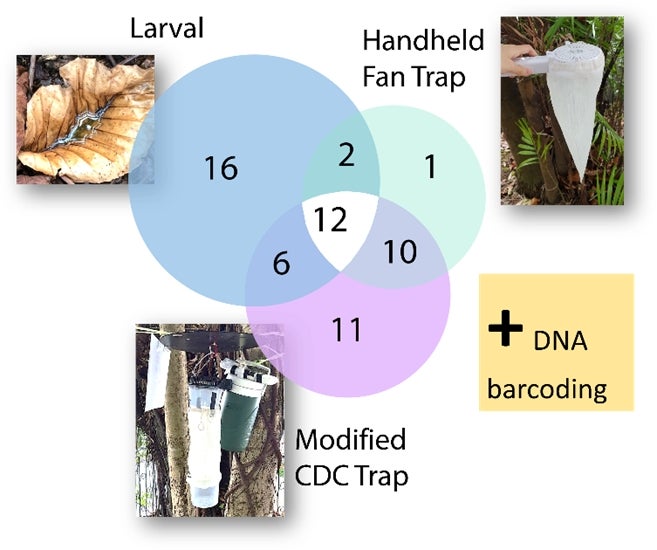Integrative approach reduces error cascades in mosquito vector surveillance
Nalini PUNIAMOORTHY (Group Leader, Biological Sciences) August 05, 2021NUS biologists demonstrate that standard surveillance methods and traditional identification techniques do not accurately reflect the mosquito community structure across different habitats. Instead, an integrated approach involving Next Generation Sequencing (NGS)-based barcoding reduces errors in analyses that impact mosquito surveillance and management.
Many vector-borne diseases are transmitted by blood-sucking flies, such as mosquitoes. Understanding disease transmission risks require knowledge of potential vectors in the area, including information on mosquito diversity and abundance. However, estimates of mosquito diversity are typically based on adult female trapping methods (such as carbon dioxide-baited traps), which tend to target host-seeking species and may represent a biased snapshot of the community structure. Although mosquitoes have discrete life stages, trapping is typically targeted at the winged adults, and the larval stages are often overlooked. Identification of mosquitoes is also challenging. Many of the species are either morphologically very similar or polymorphic, making it hard to obtain accurate diversity estimates.
The research team led by Prof Nalini PUNIAMOORTHY from the Department of Biological Sciences, National University of Singapore showed that their approach using mini-barcodes (a small DNA fragment) from an NGS platform are more accurate (see Figure). It also improves mosquito community estimates significantly as compared to traditional surveillance methods. This is important as it reduces error cascades in downstream analyses for both ecological studies and vector surveillance. Beyond mosquitoes, this finding will also be relevant for similar blood-sucking flies, such as biting midges (Ceratopogonidae) and sandflies (Phlebotominae) which are medically important but taxonomically challenging.
In this study, the team used an integrative approach using both morphological and molecular tools. They employed a variety of sampling methods to target both the adult and larval mosquitoes and demonstrated that the use of mini-barcodes can help with differentiating species of taxonomically challenging groups. Misidentification in species estimation, especially for medically relevant insect groups, can lead to conflicting reports and slow down vector control efforts.
Through the use of cytochrome c oxidase subunit I (COI) mini-barcodes, the researchers were able to improve species estimates for cryptic and polymorphic groups. These include species from taxonomically challenging mosquito species such as Aedes (Downsiomyia), Anopheles barbirostris complex and Culex (Lophoceraomyia).
By expanding their collection methods to include mosquito larvae sampling, the research team improved overall diversity estimates by 38%. They also showed that larval sampling can be informative for targeted management as they can be highly niche-specific. The findings contributed baseline knowledge on potential vectors in Singapore as some of these species have been found to harbour various pathogens in other countries and are medically relevant.
Prof Puniamoorthy said, “Rapid urbanisation and land use changes in Singapore have resulted in a highly fragmented landscape which increases contact zones between forests and densely populated urban spaces. We plan to investigate disease transmission dynamics by exploring the reproductive capacities and gene flow in generalist species that occur in diverse environments as well as forest specialists that may become invasive outside their native range due to increasing habitat loss.”

Figure shows an integrative approach with multiple collection methods. When used together with DNA barcoding, it improves mosquito community estimates as not all species can be caught by traditional trapping and identification methods. The number of species caught from each collection method are indicated in the venn diagram. [Credit: Journal of Applied Ecology]
Reference
Yeo H; Yeoh TX; Ding H; Lee ZMT; Puniamoorthy N*, “Morphology and mini-barcodes: The inclusion of larval sampling and NGS-based barcoding improves robustness of ecological analyses of mosquito communities” Journal of Applied Ecology DOI: 10.1111/1365-2664.13966. Published: 2021.


